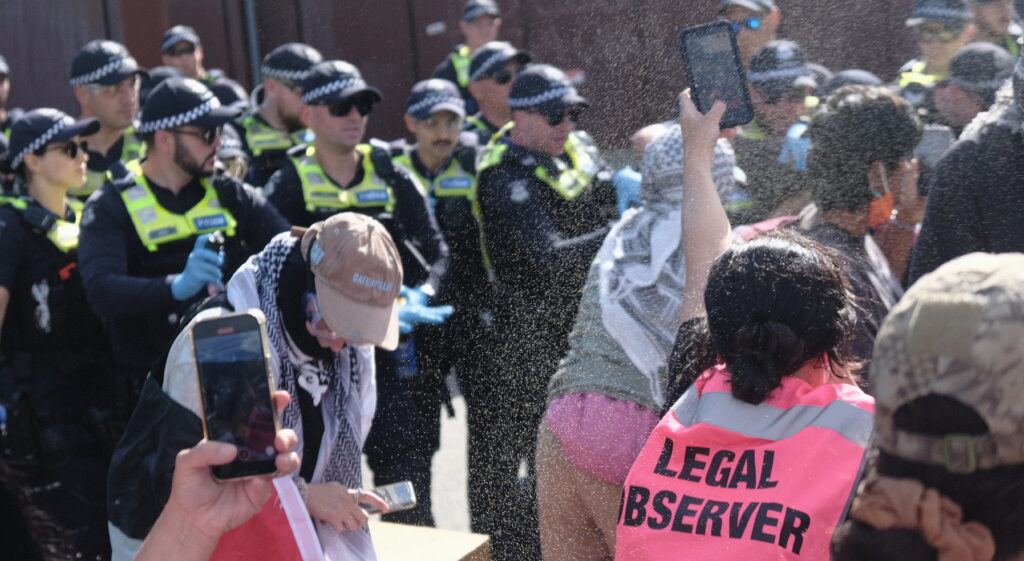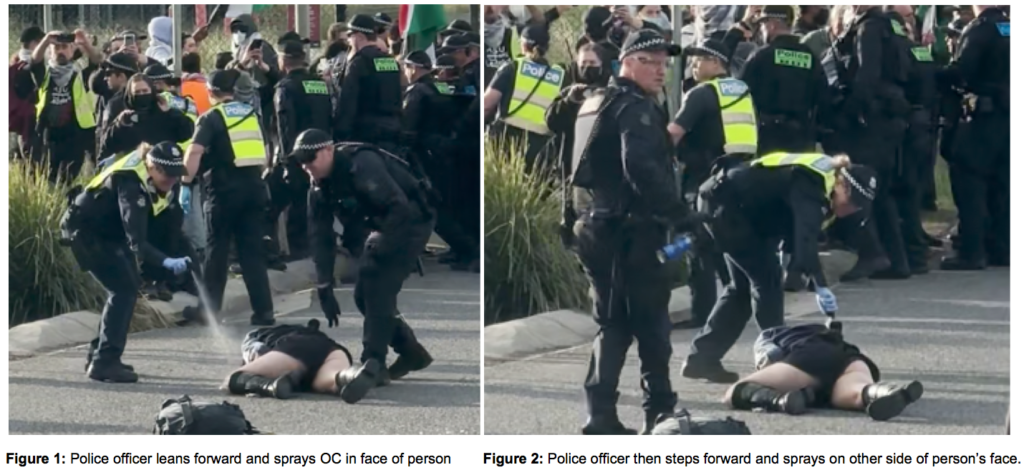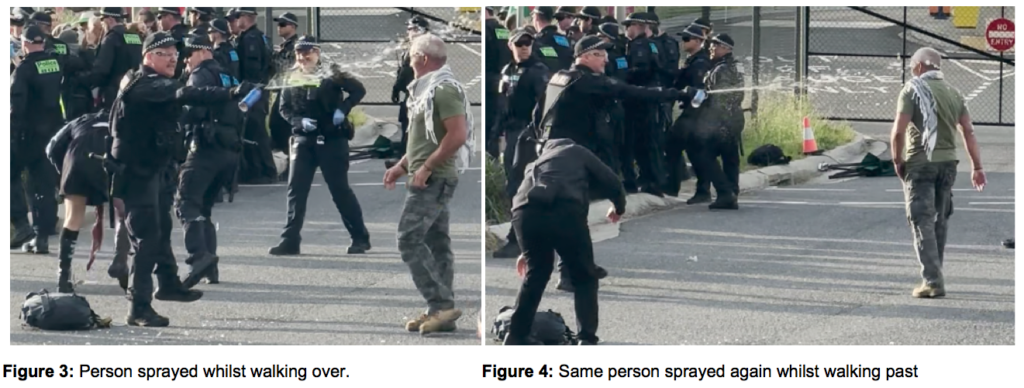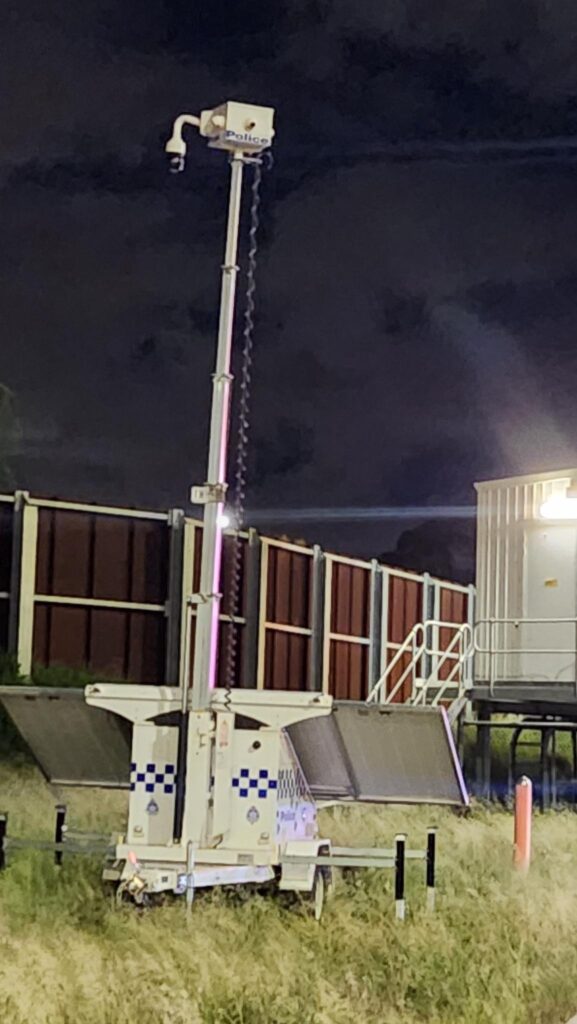Statement of Concern: Policing of the Webb Dock Picket
Port Melbourne, Victoria, Australia, 19 – 22 January 2024
Melbourne Activist Legal Support (MALS) expresses concern regarding the policing of the Webb Dock Picket between Friday, 19 January 2024 and Monday, 22 January 2024.

MALS legal observer teams had been monitoring the policing of the pro-Palestine community picket event from 4:30 pm on Friday, 19 January over several shifts.
A team of six (6) trained, independent legal observers was present during the Victoria Police operation at Webb Dock in Port Melbourne from 4:30 pm until 8:00 pm on Monday, 22 January 2024.
This statement provides observations and commentary on the following issues:
- Removal of person from wheelchair
- Mistreatment of medics and first aiders
- Unlawful use of OC (pepper) spray
- Dangerous and excessive area denial manoeuvres
- Surveillance and monitoring of protesters
- Mistreatment of legal observers
- Use of handcuffs.
Seven recommendations are included for the urgent attention of all authorities.
AREAS OF CONCERN
Removal of person from wheelchair
At approximately 5:25 pm on Monday, 22 January 2024, MALS observed and has analysed footage of a person using a wheelchair being grabbed and dragged out of their chair by police. The person was then surrounded by police, detained behind a police line. After being removed from the chair onto the ground but before the person was encircled by police, police deployed OC (pepper) spray on other protesters who were attempting to assist the person.
When police began pushing people back and shouting “MOVE, MOVE,” the person using the wheelchair had rows of police in front of them and rows of protesters behind them. The person had limited ability compared to other protesters to move away from police until either the police in front of them or the protest group behind them moved first.
Moments later, when the person was some distance from their chair, police yelled at the person to get up off the ground.
Commentary: The Victoria Police Manual (‘the VPM’) recognises that a human rights breach occurs when a human right is negatively impacted by a decision and there is not proportionate justification. The VPM directs police officers to treat people as being equal before the law without discrimination of any kind.
Every person has the right to political communication as protected through the Constitution. In Victoria, the Charter of Human Rights and Responsibilities Act (‘the Charter’) protects every person’s right to freedom of expression and peaceful assembly. These rights were negatively impacted when police officers removed the person using the wheelchair from the protest, who in the circumstances had reduced ability to move away from police.
The Equal Opportunity Act (Vic) states that direct discrimination occurs when a person with a protected attribute is treated less favourably because of that attribute. Using a mobility aid or having any form of disability should not limit a person’s ability to engage in political demonstrations more than any other person in attendance, nor place that person at a greater risk of experiencing police use of force.
The decisions of police members to remove a person from their chair and hold them behind a police line may be in breach of the VPM, the Charter, and the Equal Opportunity Act.
Unlawful use of OC (pepper) spray
Legal observers recorded multiple uses of OC (pepper) spray against people who were not posing any direct physical threat to police and were chanting, remonstrating, or attempting to communicate concerns to police at the time they were sprayed. It appeared to legal observers that on several occasions OC spray was used as a coercive attempt to move people from an area.
MALS observed and has seen footage of protesters yelling and chanting while standing close to police lines. Protesters chanting and yelling cannot reasonably be interpreted as posing a serious risk of violence or as posing a physical threat to police. Yelling and chanting does not satisfy the requirements for the lawful use of OC spray.
MALS holds further serious concerns about the misuse of OC spray on previous days of the protest.
At approximately 7:30 am on Saturday, 20 January 2024, during an attempt by police to physically move picketers from the gate at Webb Dock Drive, a person was pushed to the ground in an altercation with police during which OC spray was deployed. While the person was lying face down on the ground a senior police officer walked up, leaned over, and sprayed point blank on both sides of their face. (See Figures 1 and 2).

MALS has also seen footage showing a protester approaching police moments after this event in a non-threatening manner and being OC sprayed directly in the face. (Figure 3). A few moments later the same man is seen walking past the police about 4 metres from them, slowly with one hand in his pocket and he is again sprayed directly in the face by the same police member. (See Figure 4).

Commentary: MALS has noted the increasingly cavalier use of OC spray by Victoria Police members over a number of years. According to the VPM, police officers are permitted to use OC spray only in response to violence or a serious physical confrontation. Police are not permitted to use OC spray simply because a person is not complying with instructions.
OC spray is a harmful substance and serious part of Victoria Police weaponry. It is incredibly painful, poses serious risks to people with respiratory issues, and in protest situations often creates an atmosphere of fear and chaos. Assurances have been given by Victoria Police to the public about its correct use through statements and through the VPM. Use of OC spray outside of Victoria Police guidelines is unlawful, contrary to public expectations of police behaviour, and may constitute assault.
Mistreatment of Medics
Present at the protest on Monday evening (22 January 2024) were members of Naarm Frontline Medics, health professionals, people trained in first aid, and people equipped to treat and decontaminate those affected by OC spray.
After the use of OC spray by police, these people sought to assist and decontaminate those affected.
Treatment areas were established to gather and treat injured people. These areas were chosen as they were located away from police lines and in public areas outside the Webb Dock area. One was established in a seating area along the Todd Road bike path. It was considered that this area was safe and allowed for injured people to gather and be treated by small teams of first aiders. Legal observers witnessed this area being suddenly charged and forcibly cleared by police without warning. Several first aiders were then sprayed with OC foam while attempting to regain access to the boxes of medical, PPE, and first aid supplies left in areas that were now behind police lines. Attempts by the protest liaison and medics to regain access to their medical supplies were repeatedly denied by police, and it took over 30 minutes for senior officers to eventually provide the supplies.
A second treatment area, quickly established on the other side of Todd Road, again in a public footpath area, was also forcibly moved-on by police as they moved a line down Todd Road.
Medics reported that bags and much medical and decontamination equipment were sprayed with OC foam, rendering those items unusable.
MALS understands that at least one person attempting to treat people suffering the effects of OC spray was arrested. MALS does not currently know what charge that person is alleged to have committed.
One person attempting to assist others who were hit with OC spray has reported:
“I saw a person who said they had been hit with the spray and it was in their eyes. I yelled for a medic and we attempted to decontaminate their eyes. I took them by their elbow to a patch on the road away from the crowd that was behind small bushes. Within a minute or so police moved in on us and began pushing us. We scattered and tried to move the person with us.
Before I could get very far, I found another person who was covered in orange OC spray from head to torso. They were sitting on the nature strip and told us they were wearing contact lenses and the OC in their eyes was very painful. We attempted to prepare saline to decontaminate his eyes but police moved in on us. Initially police said we could continue decontaminating but a few minutes later police were yelling at us to move.
I overheard someone trying to explain to police that the person couldn’t move because he was severely affected. The person was shaking, screaming and could only move very slowly. The police yelled at us to pick him up and carry him. A group of us managed to help them to their feet and move further down the road but it was difficult with rapidly moving police lines.”
MALS has received reports of an ambulance being called by protesters for one person experiencing significant distress after being hit with OC spray and being treated by people on site. After the ambulance arrived and was parked behind the police line, MALS has been informed that police would not allow that person through the police line to the paramedics. Police informed a protester assisting the injured person that police would escort the person to walk up to Sandridge Beach to meet the ambulance there.
Commentary: Medics and people taking on first aid roles are volunteers who provide critical and sometimes life-preserving immediate aid to an injured person. The mistreatment and lack of concern or care for injured people and those caring for them, as well denying access to ambulance care is extremely concerning.
The VPM states that “[i]f any person is injured as a result of any Crowd Control Equipment (CCE) and Crowd Control Munitions (CCM) where practicable the Police Forward Commander must arrange after care or medical attention at the earliest opportunity” and refers to the VPMG Safe management of persons in police care or custody.
MALS does not believe that police behaviour on the Monday evening followed the procedures and guidelines in the VPMG Safe Management of Persons in police Care or Custody, or the VPMP Persons in Care or Custody.
Regardless of the situation or location, when a person is taken into police care or custody Victoria Police assumes a responsibility for their safety, security, health and welfare. Further, actions by police impact a person’s rights and freedoms under the Charter. MALS believes this applies to protest scenarios where police are in control of an area, limiting people’s movement and in effect holding people in custody via police lines.
The mandatory rules in the VPMP Persons in Care or Custody aims to ensure that the range of health, safety, security and welfare issues that persons in care or custody can present with are appropriately addressed. These rules stipulate that each person in police care or custody must be treated as an individual, having regard to their specific risks and needs. MALS does not believe that these rules were considered by police or followed during the policing on the evening in question.
The United Nations Human Rights Committee (UNHRC) General Comment No. 37 (para. 74) emphasises that law enforcement policing assemblies must protect medical personnel from harm.
General Comment No. 37 (para. 88) also states that “[w]here law enforcement officials are prepared for the use of force, or violence is considered likely, the authorities must also ensure that adequate medical facilities are available” (UNHRC, 2020, General Comment No. 37).
The use of OC spray on medics and first aiders assisting injured protesters was not justified, reasonable, nor proportionate in the circumstances. MALS views these decisions and actions of Victoria Police to constitute severe mistreatment and likely unlawful use of force.

Dangerous and excessive area denial manoeuvres
Police conducted a series of different area-denial manoeuvres over the course of Monday evening which were seemingly designed to enforce the trespass warning and direction to leave the Webb Dock precinct.
These manoeuvres included:
- static lines of police denying access to an area
- slow moving (walking pace) lines of police directing people to move ahead in front
- lines of Mounted Branch (police horses) pushing groups of people or denying access behind the police line
- fast moving (running pace) pushes towards groups of people
- charges by groups of police toward people using high levels of force to physically push and shove individuals and groups of people from an area (including first aid treatment areas described above)
- circles of police surrounding a group of people to prohibit access or egress from an area. (commonly known as ‘kettling’).
Many of these manoeuvres on Monday evening appeared unplanned, chaotic, and dangerous. Many of the manoeuvres and the way they were conducted involved high levels of physical force toward people, involving pushes, grabs, and shoves. Legal observers noted many police members shouting and yelling at people aggressively. The continually moving and changing area-denial lines resulted in escalating physical contact between police members and people who either were trying to get out of the way, people who wanted to remain in a particular location, or people who could not move easily due to injury, mobility issues, or because they were in a crowded situation. These manoeuvres and the accompanying police use of force resulted in immense anger, confusion, and distress.
By approximately 5:00 pm, after a formal trespass notice and a direction to leave the Webb Dock precinct had been read out by police, the majority of people involved in protest activity had either left the Web Dock area or had been physically pushed out by police lines through a high wall toward the footpaths and bikes paths along Todd Road or via the Webb Dock Drive/Kooringa Way intersection. Police lines were formed around the precinct at several locations to prevent vehicles or people entering or returning to the precinct.
MALS noted that police area denial lines and manoeuvres continued to force the large group people off the publicly accessible bike path and foot path areas along Todd Road onto the road itself. Police lines then forced groups in different directions down Williamstown Road to Prohasky Street and for approximately 900 metres down Todd Road to the foreshore near the Surf Life Saving Club where a long lines of police denied any return up Todd Road for approximately 40 minutes.
We note that the majority of these manoeuvres took place well outside the Webb Dock precinct that was the subject of the trespass notice and direction to leave.
At one point, a line of police and mounted police actively pushed people towards the M1 freeway. At other times people were being charged at by running police, given rapid and conflicting directions, and pushed onto roads with moving vehicles or through bushes or gardens.
Individual police were seen aggressively grabbing, pushing, and yelling at people as they were moving away or who were attempting to communicate their concerns with police. Legal observers noted multiple times when people were pushed, shoved or hit from behind by police when they were moving away from them or when they were trying to speak to or ask questions of police.
The indiscriminate use of OC foam across the crowd (on multiple occasions described above) further created and contributed to crowd confusion, panic, and distress.
Both junior and senior police present were obstructing genuine attempts by people to access their cars, their medical equipment, personal items that had been left behind the police lines. At one point referred to above, the enforcement of police lines obstructed an injured person’s access to an ambulance.
Commentary: Police lines that physically push against crowds of people can substantially escalate conflict and the risk of excessive uses of force and injury. Victoria Police are obliged to consider Charter rights in all operational decisions. All actions that limit another person’s human rights must be lawful, necessary, reasonable and proportionate, and in compliance with the Charter.
The VPM states that “[w]here possible, violent confrontation and the use of force should be avoided. Any use of force must be justified and only to the level required to reasonably effect arrest or removal of persons.”
MALS believes that numerous area-denial manoeuvres over the course of Monday evening were unnecessary, dangerous, and failed to adequately consider the human rights of people impacted. At numerous points, police refused to negotiate with protesters, failed to de-escalate situations, or unnecessarily obstructed egress and movement.
Surveillance and monitoring of protesters

MALS observed a significant level of police surveillance of protesters during the Webb Dock picket event.
On several occasions members of Victoria Police’s Evidence Gathering Team (part of the Public Order Response Team) were present filming protesters.
On Sunday, 21 January 2024, a mobile CCTV camera trailer was set up by police at the Webb Dock Drive picket site. (See Figure 5). The use, storage, and application of the data collated by this trailer is not publicly available.
Commentary: Choosing to take part in a public assembly is not an invitation to surveillance and denial of privacy. MALS reiterates previous concerns of the unnecessary surveillance of protesters and the intimidatory effect this can have on people’s rights to engage in political demonstrations.
UNHRC General Comment No. 37 (para. 62) reinforces the protection of the right to privacy: “The mere fact that a particular assembly takes place in public does not mean that participants’ privacy cannot be violated. The right to privacy may be infringed, for example, by facial recognition and other technologies that can identify individual participants in a crowd. The same applies to the monitoring of social media to glean information about participation in peaceful assemblies” (UNHRC, 2020).
Mistreatment of Legal Observers
MALS legal observers had varying experiences with police over the three day event. Police were generally receptive to legal observers on the Friday evening, Saturday and Sunday, and legal observers on site were able to introduce themselves and make contact with the Forward Commanders for each shift.
On the Monday afternoon those legal observers on Webb Dock Drive were often able to have facilitative relationships with senior officers at the site and were able to remain to observe the arrest of several people who were ‘locked-on’ to gates with padlocks.
However, other legal observers positioned with the protest group outside the Webb Dock area along Todd Road, Williamstown Road, and The Boulevard experienced several instances of mistreatment by police. These included:
- being repeatedly and often aggressively questioned about the legitimacy of their role and their right to be present at the site
- initially being refused access to the site
- being erroneously directed by police that they were part of the protest
- refused access to protesters behind police lines
- refused access to communications with officers in charge
- being pushed and held in a police cordon by police.
One legal observer was hit with OC spray across the face and eyes. While someone was attempting to decontaminate the legal observer, police and mounted police ran at the crowd including towards the legal observer. This caused people to scatter and effectively prevented the first aid treatment and decontamination of the legal observer.
These combined actions by police effectively hindered the ability of the MALS legal observer team to fulfil its role.
Commentary: MALS has raised this issue with Victoria Police on several previous occasions. Any use of force against legal observers is entirely unacceptable.
Independent monitoring of the policing of protests is essential for defending the right to organise and participate in public assemblies. The practice of independent scrutiny of police is recognised by the UNHRC. The UNHRC describes monitoring as necessary for the exercise of the right to peaceful assembly, emphasising the duties of law enforcement officials to “[protect] journalists, monitors and observers” (UNHRC, 2020).
UNHRC General Comment No. 37 (para. 30) also specifically adds that “[observers] may not be prohibited from, or unduly limited in, exercising these functions, including with respect to monitoring the actions of law enforcement officials. They must not face reprisals or other harassment, and their equipment must not be confiscated or damaged. Even if an assembly is declared unlawful or is dispersed, that does not terminate the right to monitor”(UNHRC, 2020).

Use of handcuffs
MALS observed several arrested people placed in handcuffs after being removed from lock-ons who were compliant, not aggressive, clearly not at risk of absconding, and who were continuously accompanied by one to two officers.
In these circumstances MALS observed that the use of handcuffs was not reasonably necessary nor proportionate and may have constituted a restriction of Charter rights.
Commentary: The use of handcuffs is a use of force and must be only be done when it is reasonable, necessary, and proportionate in the circumstances. The VPM states that handcuffs should only be used if it is reasonably necessary in the circumstances.
The use of handcuffs observed by MALS in these cases may have been unlawful and in breach of the VPM.
ACTIONS AND RECOMMENDATIONS
In light of the above areas of concern, Melbourne Activist Legal Support calls upon all authorities to ensure the following:
- As a bare minimum, Victoria Police take proactive measures to ensure that officers comply with laws and policies governing the use of force at public assemblies.
- The Independent Broad-based Anti-Corruption Commission (IBAC) and the Victoria Equal Opportunity and Human Rights Commission (VEOHRC) investigate the operational decisions made on Monday as to the extent they may have breached the Charter and what measures may be applied to prevent re-occurrence.
- Victoria Police consult with bodies such as VEOHRC to review its Victoria Police Manual (VPM) policies, police attendance at events and incidents, operational planning, and operation orders in relation to all large civil disobedience protest events in order to ensure that the rights to peaceful assembly, association and expression are not limited by operational tactics that demonstrate bias or allow or facilitate discrimination, and are aligned with the UNHRC General Comment No. 37 (2020).
- Victoria Police, as a matter of urgency, review policies, operational planning, and operational orders in relation to the treatment of medics, first aiders, and access to first aid treatment at protest events in order to ensure that the right to access medical care is not impeded, and that the obligation to protect medical personnel is aligned with the UNHRC General Comment No. 37 (2020).
- Victoria Police immediately restrict the Mounted Branch to ceremonial and patrol duties only, and specifically prohibit any use of police horses in public order or crowd control scenarios.
- Victoria Police provide clear directives to members and reinforce Operational Safety and Tactics Training (OSTT) regulations and training to prevent further unlawful use of OC aerosols against civilians involved in peaceful but non-compliant forms of protest activity.
- Victoria Police specifically include the role of civilian legal and human rights observers within the Victoria Police Manual Crowd Control Guidelines (VPMG) and for Forward Commanders to brief operational members of the requirement to ensure the safety and access of legal observers who may be present at protest events.
This Statement of Concern is a public document and is provided to media, the Victoria Police Professional Standards Command (PSC), the Independent Broad-based Anti-corruption Commission (IBAC), the Victorian Equal Opportunity and Human Rights Commission (VEOHRC), Government ministers, Members of Parliament, international human rights agencies, and other agencies upon request.
For inquiries regarding this statement please contact MALS.